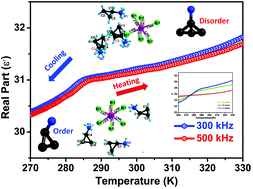Structural phase transition and dielectric anisotropy properties of a lead-free organic–inorganic hybrid†
Abstract
Organic–inorganic hybrids have shown great potential for assembling dielectric phase transition materials, due to their unique characteristics and structural diversities. Here, we construct a new organic–organic hybrid, (cyclopropylaminium)3BiBr6 (1), which consists of a zero-dimensional inorganic framework of BiBr6 octahedra and ternary cyclic organic cations. It is noteworthy that 1 undergoes a reversible phase transition around Tc = 288 K upon heating, as certified by dielectric and DSC measurements. Variable-temperature structure analyses disclose that the dynamic order–disorder behavior of ternary cyclic organic cations accounts for the phase transition. That is, the frozen ordering of highly-disordered organic cations affords the driving force. Dielectric constants of 1 also exhibit two distinct states in the vicinity of Tc associated with its phase transition, corresponding to the high- and low-dielectric states. Particularly, an obvious dielectric anisotropy is observed along its different crystallographic axis directions; in detail, dielectric anomalies along the c-axis are larger than those along the a- and b-axis. Besides, 1 possesses an optical energy bandgap of ∼2.8 eV determined by its inorganic framework. Such dielectric activities induced by order–disorder transformation may highlight a pathway for the design of new electric-ordered materials.



 Please wait while we load your content...
Please wait while we load your content...